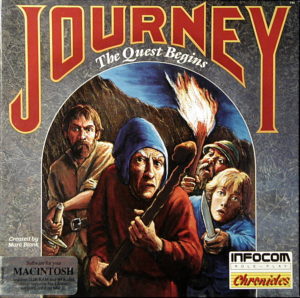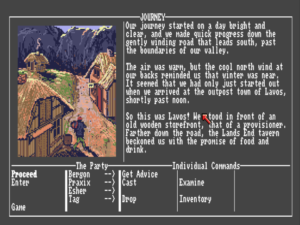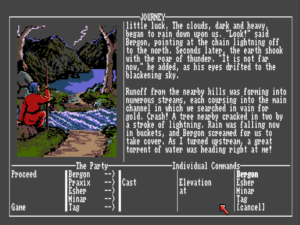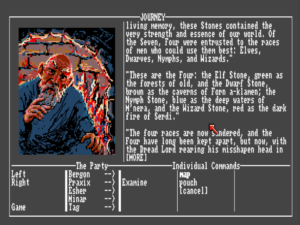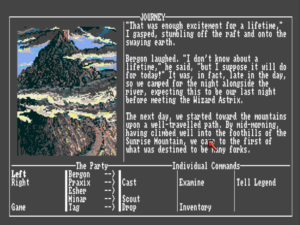The parser is and has always been both the text adventure’s ace in the hole and its Achilles heel. Devotees will tell you, correctly in my opinion, that it offers possibilities for interaction — even, one might say, possibilities for interactive wonder — allowed by no other interface. Detractors will tell you, also correctly, that it’s too persnickety, too difficult to use, that in its opacity and inscrutability it violates every rule of modern interface design. Devotees will reply, yet again in my opinion correctly, that if you take away the parser you take away the magic. What can compare with typing some crazy command and seeing it work? What, the detractors reply, can frustrate more than figuring out what to do, not being able to get the parser to acknowledge your efforts, turning to a walkthrough, and finding out you were simply using the wrong verb or the wrong phrasing? And so we go, round and round and round. This waltz of point and counterpoint says as much about the text adventure’s decidedly limited mass appeal as it does about why some of us love the form so darn much.
For most of the text adventure’s lifespan people have been devising various ways to try to break the cycle, to capture at least some of the magic without any of the pain. Even Infocom, whose parser was legendary in its day, had a go in their final days at doing away with the gnarly, troublesome thing altogether, via a game called Journey.
The idea that became Journey can be dated to November 6, 1987, when a proposed “new project” emerged from an internal planning meeting. By that point, attitudes about Infocom’s future prospects had broken into two schools of thought. One view, still dominant inside Infocom’s own offices but viewed with increasing skepticism in the headquarters of their corporate masters Mediagenic, [1]Mediagenic was known as Activision until mid-1988. To avoid confusion, I just stick with the name “Mediagenic” in this article. held that the fundamental model of interaction that Infocom’s games had always utilized, that of reading text and typing commands in response, was still commercially viable in the broad strokes. What was needed was to make that model a bit more visually appealing and accessible, by adding pictures and other audiovisual pizazz to break up their walls of text and by making the parser smarter and friendlier. The other view held that Infocom needed to throw out all their old approaches — among them their parser — and tackle their new role as Mediagenic’s designated “master storytellers” with an entirely blank slate. Conservatives versus radicals, denialists versus realists — call the camps what you will, the lines were drawn.
True to the dominant internal opinion, Infocom put the majority of their resources into one last kick at the can for their parser-based games, putting three new illustrated but still parser-driven text adventures into development. They hedged their bets just a little, however, by making sure the new version 6 Z-Machine they had in development to power those games could support purely mouse-based point-and-click interaction as well as the traditional keyboard-driven approach. And then they started this “new project” of theirs to see what the possibilities for non-parser-based adventuring might really be.
The meeting notes read that said new project should be “true to [the] corporate philosophy”; that it should “embody the concept of ‘interactive storytelling'”; that it should “employ a simple, intuitive user interface unlike the one used in our traditional IF games”; and that, while initially “intended for use on existing home computers,” it should be “readily adaptable to other interactive media, such as CD-I, DVI, Nintendo, etc.” Finally, the plan called for “minimal (or optional) use of text.” This last would fall by the wayside in light of Infocom’s limited resources and complete lack of experience working in anything other than text; instead they would settle for lots of pictures to accompany the text. Otherwise, though, the game Marc Blank wrote in response to this plan would hew quite closely to it.
Ironically, it was Blank who had been the mastermind behind the magnificent parser, first implemented as part of the original Zork at MIT, that had been so key to Infocom’s ascendancy during the first half of the 1980s. Now he would be working on the interface that might just become its replacement if the conservative camp should prove mistaken in their faith in the old ways. But then, Blank wasn’t much of a sentimentalist. Assuming he thought of it at all, the idea of sounding the death knell of the traditional Infocom game didn’t bother him one bit. On the contrary, this new project was a perfect fit for Blank, exactly the sort of medium-advancing technical challenge he loved. He insists today that throughout his work with Infocom game design and story were always secondary in his mind to the technology that enabled them. Thus virtually every one of the games with which he was most intimately involved, whether as the officially recognized Implementor or the self-styled “wizard behind the curtain” enabling the creativity of another, pushed Infocom’s technology forward in one way or another. That would be more true than ever of Journey, which Blank created, as he had Border Zone, from the West Coast, working as an independent contractor rather than an Infocom employee. Blank:
Journey was an experiment to find out whether you could play an interactive story without having to type. It was all about whether you could still have people feel they had the ability to do a lot of different things, but not force them to guess words or use a keyboard. A lot of people just don’t like that; they aren’t good at it. It’s a turn-off. For me, the idea was to just experiment with another style of evolving the story — a different interface, just to see where it would go.
Even more so conceptually than technically, this new interface of his was going to be a tricky business. A bunch of hard-branching links in the form of a computerized Choose Your Own Adventure book was likely to appeal to no one. At the same time, though, to simply write a traditional text adventure in which the parser was a menu-based labyrinth of verbs and nouns would be both technically impractical — there wouldn’t be enough space on the screen for such a thing for one thing, and even the new version 6 Z-Machine didn’t support scrolling menus — and unplayable in its sheer complication. Blank would need to thread the needle, staking a middle ground between the extreme granularity of Zork and the huge irreversible plot swings that accompany almost every branch in a Choose Your Own Adventure book. To a rather remarkable degree really, he succeeded in doing just that.
Blank’s first brilliant stroke was to make Journey, if not quite a full-fledged CRPG, at least a CRPG-like experience. You the player identify most closely with a single character named Tag, who also serves as the author of the past-tense “chronicle” of the adventure that you’re helping him to create. You’re responsible for managing several of his companions in adventure as well, however, each with his own strengths, weaknesses, and special abilities. Most notably, the wizard Praxix can cast spells, each of which requires a certain combination of reagents which you’ll need to collect over the course of your Journey. Many problems can be solved in multiple ways, using different spells or combinations of spells, the special abilities of one character or another, and/or your own native cleverness. While the scope of possibility in Journey is undeniably limited in comparison to a traditional Infocom game, in practice it feels broader than you might expect.
To understand a little better how that might be, let’s have a closer look at the interface, as shown in the screenshot above. You’ll notice that the menu at the bottom of the screen is divided into five columns. The first contains possibilities that apply to the entire party — usually involving movement — along with access to the “Game” menu of utility commands. The second column, which isn’t actually clickable, lists each character in the party; the party can include up to five people, who can come and go according to choices and circumstances. The third, fourth, and fifth columns contain “verbs” applying only to the individual party member whose row they inhabit; these also come and go as circumstances change. Many verbs will lead to a further menu or menus of “nouns.” For example, asking Praxix the wizard to “cast” leads first to a direct-object list of available spells, and then on to an indirect-object list of possible spell targets, as shown in the screenshot below. Clicking on the name of Bergon to the far right on that screen would complete a command equivalent to typing “cast elevation on Bergon” in a traditional Infocom game. The whole system is elegant and well thought-through. Limited though it may be in contrast to a parser, it nevertheless presents a vastly larger possibility space than a Choose Your Own Adventure story, not least because it has a world model behind it that’s not all that far removed from the one found in any other Infocom game.
Journey is, as you’ve doubtless gathered by now, a high-fantasy story, a quality that, combined with the CRPG-like flavor, delighted a beleaguered marketing department still searching desperately for a counter to the huge popularity of the Ultima, Bard’s Tale, and Advanced Dungeons & Dragons series. Looking for a way to distinguish it from Infocom’s more traditional “graphical interactive fiction,” marketing dubbed it a “role-play chronicle” — not exactly a phrase that trips off the tongue. Blank:
I wanted to call it ‘role-playing fiction.’ They came back with role-play chronicle, and I said, “What does that mean?” They said, “Well, it’s like a chronicle,” and I said, “Yeah, it sort of is because it’s told in the past tense.” So they just sort of invented a phrase. It’s not my favorite, but it’s passable, and I don’t think Journey will stand or fall on what category you put it in. There are a lot of games that are called this type or that, but what really matters is what people think of them.
Awkward though marketing’s name may have been, there is indeed some truth behind it. One of the more interesting aspects of the game is its commitment to the idea of being a chronicle — or, if you like, a novel — that you, through Tag, are creating as you play. If you choose to make a transcript of your adventure, you can opt to have it not include your explicit command choices if you like, just the text that appears in response. The end result can read surprisingly well — a little disjointed at times, yes, but far better than would, say, Zork in this format.
There is, granted, no denying the story’s derivative nature; this is a game that absolutely oozes Tolkien, a fact that Infocom’s marketing department, far from concealing or denying, trumpeted. Journey, runs the game’s official announcement in Infocom’s The Status Line newsletter, is “a classic narrative in the exciting tradition of Tolkien” that “plunges you into an uncharted world of dwarves, elves, nymphs, and wizards.” True to its inspiration, Tag, ultimately the hero of the story, is seemingly the meekest and weakest of a group of disparate companions who form a fellowship and set out on a lonely quest to save their land from an encroaching evil that threatens their civilization’s very existence. Sound familiar? Name a proper noun in The Fellowship of the Ring, and chances are it has an analogue in Journey.
For instance, in place of Tolkien’s magic rings Journey has magic stones as the key to defeating the Dread Lord, its version of Sauron. In this extract, Gandalf… I mean, the great wizard Astrix tells the party of the true nature of their quest.
"I have been following your progress with great interest," the Wizard said, stroking his stringy gray beard. "You are a very resourceful group, that is certain!"
His voice then became dark. "The question is: Have you mettle enough to make siege on the Dread Lord himself?" And then, smiling, the darkness fell from his voice, and he answered his own question, "We shall see, I suppose; we shall see."
Leading us to his hearth, he sat us in a semi-circle around the blazing fire and spoke. "There is a story I must tell, a story of Seven Stones. Created in a time lost to living memory, these Stones contained the very strength and essence of our world. Of the Seven, Four were entrusted to the races of men who could use them best: Elves, Dwarves, Nymphs, and Wizards.
"These are the Four: the Elf Stone, green as the forests of old, and the Dwarf Stone, brown as the caverns of Forn a-klamen; the Nymph Stone, blue as the deep waters of M'nera, and the Wizard Stone, red as the dark fire of Serdi.
"The four races are now sundered, and the Four have long been kept apart, but now, with the Dread Lord rearing his misshapen head in our lands, we must bring them together again. For with them, we can hope to find the Two, and then, finally, the One with whose help we can destroy all Evil.
"For it is told that having the Four, it is possible to find the Two; so, also, do the Two give witness to their master, the One that in elder days was called the Anvil!"
Yet somehow Journey is far less cringe-worthy than it ought to be. For a designer who stubbornly, almost passive-aggressively insists today that the technology “was more important than the story” to him, Blank delivered some pretty fine writing at times for Infocom. Journey is full of sturdy, unpretentious prose evoking a world that, overwhelmingly derivative though it is, really does manage to feel epic and interesting in a way too few other gaming fictions have matched in my experience. I was always interested to explore the world’s various corners, always happy and genuinely curious when the opportunity arose for Tag to learn a little more about it from one of the other characters. Coming from me, someone who generally finds the real world much more interesting than fantastical ones, that’s high praise.
Indeed, when I first began to play Journey I was surprised at how much I enjoyed the whole experience. Not expecting to think much of this oddball effort released in Infocom’s dying days, I’d put off playing it for a long, long time; Journey was the very last of the 35 canonical Infocom games that I actually played. Yet when I finally did so I found it a unique and very pleasant experience. It felt very much like what I presumed it to be attempting to be: a more easygoing, relaxed take on the adventure game, where I could feel free to just take in the scenery and enjoy the story instead of stressing too much over puzzles or worrying overmuch about logistics. The game’s own rhetoric, obviously trying to wean players of conventional interactive fiction into this new way of doing things, encourages just such a relaxed approach. “Try to play as much as possible without overusing Save,” says the manual. “There are no ‘dead ends’ in Journey; feel free to experiment and take chances. Every action you take will cause the story to move forward.” This idea of a text adventure with no dead ends encourages comparisons with the contemporary works of Lucasfilm Games in the graphic-adventure realm, who were working toward the same goal in response to the notoriously player-hostile designs of Sierra. Marc Blank’s contemporary interview comments make the comparison feel even more apt:
We’ve learned a lot about interactive storytelling, but it’s been sort of clunky and not directed. I thought it would be interesting to design a story in which you really couldn’t get stuck. The choices you have to make are more tied into the story than into the minutia of manipulating objects. That really led to the whole style of telling the story and the interface. All that came out of the desire to try something like that.
So, yes, Journey and I had a great relationship for quite a while. And then it all went off the rails.
The first sneaking suspicion that something is rotten at the core of Journey may come when it hits you with some puzzles mid-way in that suddenly demand you type in phrases at a command line. Not only a betrayal of the “no-typing” premise that Infocom had hoped would make Journey amenable to game consoles and standalone CD-ROM players, these puzzles aren’t even particularly worthy in their own right, requiring intuitive leaps that feel borderline unfair, especially in contrast to the consummate ease with which the rest of the game is played. But, alas, they’re far from the worst of Journey‘s sins.
For there inevitably comes a point when you realize that everything Infocom has been saying about their game and everything the game has been implying about itself is a lie. Far from being the more easy-going sort of text adventure that it’s purported to be, Journey is a minefield of the very dead ends it decries, a cruel betrayal of everything it supposedly stands for. It turns out that there is exactly one correct path through the dozens of significant choices you make in playing the game to completion. Make one wrong choice and it’s all over. Worse — far worse — more often than not you are given no clue about the irrecoverable blunder you’ve just made. You might play on for hours before being brought up short.
The worst offenders to all notions of fairness and fun cluster around the magic system and its reagents. Remember those puzzles I mentioned that can be solved in multiple ways? Well, that’s true enough in the short term, but in the long term failing to solve each one in the arbitrary right way — i.e., solving it by using a spell instead of your wits, or simply by using the wrong spell — leaves you high and dry later on, without the necessary reagents you need to get further. Playing Journey becomes an exercise in stepping again and again through the story you already know, clicking your way hurriedly through the same text you’ve already read ten times or more, making slight adjustments each time through so as to get past whatever dead end stymied you last time. This process is exactly as much fun as it sounds. In contrast to this exercise in aggravation, Shogun‘s summary halting with a “this scene is no longer winnable” message when you fail to do what the novel’s version of Blackthorne did suddenly doesn’t seem so bad.
How incredible to think that Journey and Shogun stemmed from Marc Blank and Dave Lebling, designers of the original Zork and Infocom’s two most veteran Implementors of all. These two of all people ought to have known better. Both games’ failings feel part and parcel of the general malaise infecting everything Infocom did or tried to do after 1987. Absolutely nothing that anyone did seemed to come out right anymore.
As bizarre as it is to see such frankly awful game design from a company like Infocom and an Implementor like Marc Blank, the disconnect between the rhetoric and the reality of Journey is still stranger. “Unlike other games you may have played, there are virtually no dead ends,” the manual promises. “Any action you take will advance the story toward one of its many endings.” I suppose there’s a germ of truthfulness here if you count a dead end only as being stranded in a walking-dead situation; the nature of Journey‘s interface means that you will always get a clear message that the jig is up once you’ve run out of options to move forward, sometimes even accompanied by a helpful hint about where you might have messed up way back when. Still, the assertion seems disingenuous at best. When people talk about multiple endings and multiple paths through an interactive story, this isn’t quite what they mean. Ditto Blank’s contemporary claim that there are “dozens” of “alternative endings,” and “very few places where you get killed.” Really, what’s the practical difference between a losing ending that involves death and one that leaves Tag and his friends defeated in their quest? The Dread Lord wins either way.
Today, none of the people left at Infocom during this final unpleasant period of the company’s existence are particularly eager to talk about those painful end times or the final batch of underwhelming games they produced. Thus I’ve never seen anyone even begin to address the fraught question of just what the hell they were thinking in trying to sell this sow’s ear of a game as a silk purse. Part of the disconnect may have stemmed from the physical distance between Marc Blank and the people at Infocom who wrote the manual and did the marketing; this distance prevented Blank from being as intimately involved in every aspect of his game’s presentation as had long been the norm for the in-house team of Imps. And part of the problem may be that the rhetoric around the game was never modified after the original vision for Journey became the cut-down reality necessitated by time pressure and the space limitations of even the latest version 6 Z-Machine. (While Journey‘s text feels quite expansive in comparison to the typical parser-based Infocom game, Blank was still limited to around 70,000 words in total; the perception of loquacity is doubtless aided by the fact that, Journey‘s scope of player possibility being so much more limited, a much larger percentage of that text can be deployed in service of the main channel of the narrative rather than tributaries that many or most players will never see.) Regardless of the reasons, Journey stands as the most blatant and shameless instance of false advertising in Infocom’s history. It’s really, really hard to square marketing’s claim of “no dead ends” with a game that not only includes dead ends but will end up being defined by them in any player’s memory. Infocom was usually better than this — but then, that’s a statement one finds oneself making too often when looking at their final, troubled run of games.
True to the Tolkien model to the last, Infocom planned to make Journey the first of a trilogy of games, the latter entries of which would likely have been written by other authors. Blank proposed starting on an untitled sort of narrative war game as his own next project, “a variant of traditional FRP [fantasy-role-playing] games in which the predominant activity is combat on the battlefield level, as opposed to the hand-to-hand level.” It would use the menu-driven Journey interface to “make a complex game simple to use and learn” and to “provide a narrative force to the unfolding of the war.” But events that followed shortly after the concurrent release and complete commercial failure of Journey and Shogun in March of 1989 put the kibosh on any further use of Journey‘s interface in any context.
And that’s a shame because its interface had huge potential to bridge the gap between the micromanagement entailed by a parser and the sweeping, unsatisfyingly arbitrary plot-branching of a Choose Your Own Adventure book. It’s only in the past decade or so that modern authors have returned to the middle ground first explored by Blank in Journey, constructing choice-based works that include a substantial degree of world modeling behind their text and a more sophisticated approach to interaction than a tangle of irrevocable hard branches. In the years since they began to do so, the quantity of choice-based works submitted to the annual Interactive Fiction Competition has come to rival or exceed those of more traditional parser-based games, and commercial developers like Inkle Studios have enjoyed some financial success with the model. While they provide a very different experience than a parser-based game, my own early engagement with Journey demonstrates how compelling games of this stripe can be on their own terms. And they’re certainly much more viable than traditional text adventures as popular propositions, being so much more accessible to the parser-loathing majority of players.
Unsatisfactory though it is as a game, Journey marks Infocom’s final mad flash of innovation — a flash of innovation so forward-thinking that it would take other developers working in the field of interactive narrative a good fifteen years to catch up to it. Perhaps, then, it’s not such a terrible final legacy after all for Marc Blank in his role as Infocom’s innovator-in-chief — a role he continued to play, as Journey so amply proves, right to the end.
(Sources: As usual with my Infocom articles, much of this one is drawn from the full Get Lamp interview archives which Jason Scott so kindly shared with me. Some of it is also drawn from Jason’s “Infocom Cabinet” of vintage documents. Plus the May 1989 issue of Questbusters, and the very last issue of Infocom’s The Status Line newsletter, from Spring 1989.)
Footnotes
| ↑1 | Mediagenic was known as Activision until mid-1988. To avoid confusion, I just stick with the name “Mediagenic” in this article. |
|---|
